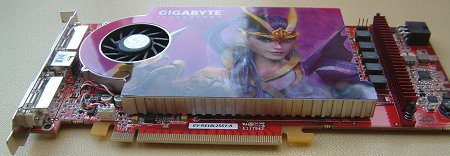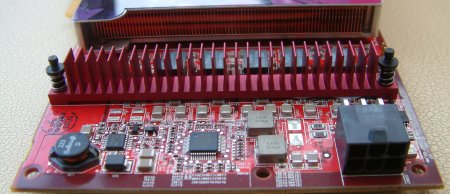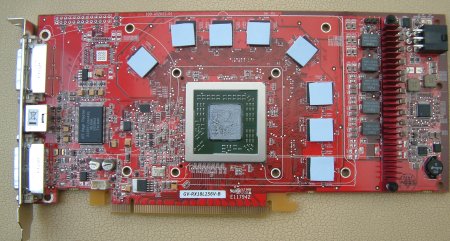Card appearance and thoughts

Reference design strikes again, this time with Gigabyte. There's not much to say about it that hasn't been said before. As usual, the only differentiating factor between this and a genuine reference ATI Radeon X1800 XL 256MB card is the artwork on the heatsink's plate and company-specific sticker on the fan. Change these around to say, ASUS, HIS, or SAPPHIRE, and you simply wouldn't know which was which. Product differentiation, therefore, won't be made on card design.
Taking reference matters further, Gigabyte's PCI-Express-based PCB measures in at just under 23cm, so those of you with smaller cases will need to ensure that it will fit without obstructing other components.

A slightly different look shows that Radeon X1800 XLs, as opposed to X1800 XTs, use single-slot coolers with an off-centre fan that blows air through the heatsink's fins and back into the case. During 2D testing the card's 40mm fan, spinning at ~3,200RPM, was quiet enough to be masked by the system's fans, but during heavy 3D load, the fan, like pretty much every other Radeon X1800 XL 256MB's under the sun, would consistently change speed from low to high (~5,300RPM), which, readers, is loud enough to become intrusive very quickly. Here's where an individual design from any of ATI's card partners would have been beneficial, say a larger fan spinning at slower speeds.

A closer look at the front of the card shows us that, via the 6-pin PCIe power connector, extra juice is required for ATI's 321million transistor-filled R520 GPU to function at the XL's prescribed 500MHz core speed, along with GDDR3 memory chugging along at an effective 1000MHz. You can also see the copper fins of the heatsink in the background, and it's in this direction that the GPU's fan blows warm air, right over the thin heatsink that covers power-delivery components.

Dual-DVI goodness lines the rear of the card, such that you can run displays with extra-high resolutions without any problems. Want to run a 2560x1600 screen off just one transmitter? No problem. This feature is more pertinent than you might think, as there's more than one vendor espousing the wonders of 2560x1600 panels. Keeping in with reference tradition, ATI's Rage Theater ASIC provides basic VIVO functionality on Gigabyte's card, and signals are received/outputted through the socket in the middle.

Stripping away the cooler, which carries the majority of the card's weight, shows us the bare card. 8 256MBit Samsung GDDR3 1.4ns-rated DRAM modules are hidden from view, obscured by thermal pads that make contact with the cooler. The venerable ATI Rage Theater ASIC sits the left, providing the basic VIVO usage we talked about above. Note just how large the R520 core is. 321million transistors, based on a 90nm manufacturing process, still take a chunk of space. Looking at the bare card again, you get the feeling that ATI could have made it smaller, perhaps closer to the R480's PCB size.

The back of the card holds no surprises at all. A simple brace helps keep decent pressure between copper-based heatsink and the 90nm R520 core.
It's reference pretty much all the way here. That also denotes multi-GPU CrossFire compatibility once master cards hit the retail shelves in volume.









